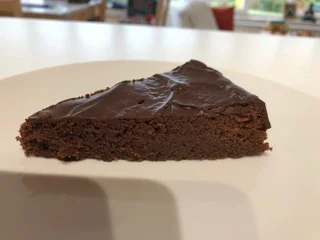
Jill's Chickpea Curry
Ingredients:
1 tbsp olive oil
1 onion, chopped
1 large tin chickpeas
1 tin chopped tomatoes
1 tsp coriander
1 tsp ground cumin
1/2 tsp turmeric
1 clove garlic, crushed
Thumb of ginger, crushed
1 or 2 green chillies, finely chopped
Handful of chopped fresh coriander to top
Juice of half a lemon
Serve with rice (optional)
Method:
Heat oil in a large frying pan and fry the onion until just starting to go brown
Add dry spices and cook for a few minutes before adding the chillies, garlic and ginger
Add tomatoes and chickpeas. Cook for 15 minutes on a medium heat, stirring regularly
Add lemon juice and coriander before serving with rice, naan bread etc.
Jill's Gluten, Dairy & Refined Sugar Free Chocolate Cake
Gateau de Nancy
Ingredients:
125g Pure Margarine (I prefer the Sunflower one)
125g 70% dark chocolate (I use Lindt)
4 eggs
125g coconut sugar (or brown caster sugar if you don’t mind the sugar content)
25g gluten free flour
¼ teaspoon baking powder
100g ground almonds
…
Gateau de Nancy
Ingredients:
125g Pure Margarine (I prefer the Sunflower one)
125g 70% dark chocolate (I use Lindt)
4 eggs
125g coconut sugar (or brown caster sugar if you don’t mind the sugar content)
25g gluten free flour
¼ teaspoon baking powder
100g ground almonds
Topping:
100g 70% chocolate
4 tablespoons water
30g Pure
Method:
Preheat oven to 150/300 degrees
1. Cream the Pure using a handheld or electric whisk.
2. Break the chocolate into smallish pieces and melt (either in Bain Marie or microwave – I do it in the microwave – 1 minute on full power and then stir until last few ‘lumps’ disappear).
3. Add chocolate to Pure and mix well.
4. Separate eggs and add just yolks to mix.
5. Add sugar and mix well.
6. Add flour, baking powder and ground almonds.
7. Whisk egg whites until stiff and then fold into mix carefully until combined.
8. I line the base of my tin and wipe the sides with Pure.
9. Bake for 25 to 35 mins (depends on oven I have found), so check after 25 mins until skewer, inserted in middle comes out clean. Don’t overbake!
10. Whilst cake cooking, make topping. Melt chocolate and add Pure and water. You will find that the mix ‘stiffens’ a little as you add the Pure and water, but just stir or whisk hard until it is smooth and glossy. You can add more water, but do so sparingly.
As soon as cake is cooked, take out of oven and invert on to serving plate and cover immediately with topping (this helps retain its moistness). Leave to cool and enjoy.
Jill's everything but the kitchen sink Kimchi - for good gut health!
The Kimchi festering before potting
I've learned an awful lot about gut health this past ten months. Eben was born with gut issues, a result of his entrance into the world - six weeks early, Caesarean Section, administered antibiotics upon birth, kept in a sterile incubator without much human touch those first few days of his life. It was far from ideal and has resulted in a lack of good microbes, which means he is intolerant to lots of things.
And when I say lots of things, I mean lots of things - dairy, wheat, gluten, oats, soya, tomatoes, strawberries, and peppers. If he eats any of these things then his digestion is compromised (constipation mainly) and his skin flares up with eczema.
It's been quite some journey managing this, not only for him but for me too given that I've been breastfeeding him. We've followed the GAPS diet as best we can, with bone broth (yep, I even ate organic chicken for a time), lots of coconut oil, olive oil and fermented foods. My Mum's been helping lots and has made this wonderful 'Everything but the kitchen sink' Kimchi", which I share with you here:
Jill's everything but the kitchen sink Kimchi
There are many recipes for Kimchi but I guess the overriding difference to Sauerkraut is the inclusion of chillies.
Ingredients
1 small daikon/mouli grated (I got mine from Forest Stores and they are large, so I only used half in this recipe. You could use ordinary radishes instead and would need at least a whole packet)
2 large carrots (or equivalent) grated
1 apple grated
1 onion (red or white) or a bunch of spring onions, chopped
1 cabbage, sliced (core removed and cabbage quartered). KEEP 2 or 3 of the outer leaves for 'sealing' the mix in the jar.
1/2 bunch kale (red/white or both) or pack of small pack choi, sliced
5cm piece of ginger, finely grated
2 or 3 red chillies finely chopped or 1 to 2 teaspoons chilli flakes (to taste)
4 or 5 cloves of garlic, finely grated or minced (you do need some garlic but can reduce this amount if not keen or increase - to taste)
2 tablespoons fish sauce or dulse flakes (the latter from Hansa)
2 tablespoons Himalayan pink salt (or sea salt such as Celtic salt - as long as it is decent quality.
Using your hands mix it all in a large glass or ceramic bowl, squeezing it as you do so to start the release of the juices. If you do this in the morning you can transfer it to jars later that day. If made later in the day it should be left overnight before potting.
When potting, pack it down so that you force the juices to cover it, but don't pack right to the top of the jar, leave 4 - 5 cm. Fold one of the retained outer cabbage leaves to create a 'lid' inside the jar, then use a bit of carrot set in the middle of the leaf, a little bit higher than the lid, so that as you screw the lid on, it forces the leaf down and ensures the juices cover the mix. DON'T screw the lid tightly at this point as you need to leave it on a work surface for 3 days so that it starts to fizz a little. You can leave it longer but after those 3 days the lids can be screwed on tightly and it can now be stored in the fridge for up to 3 months (if it lasts that long - it is moreish!).
You can vary the vegetables, although cabbage is a staple in it.
Packed into jars, see the liquid near the top
Use the retained outer leaves, folded, to 'seal' the kimchi below. Use carrot, a little higher than the lid, to push the seal down when you put the top on.
With the lids on loosely, you can clearly see the liquid right up to the top.
Yummy immune Boosting Soup Recipe
I can’t take credit for the recipe, it’s been adapted from one given to me from an Australian cookbook…its incredibly yummy, and very good for you!
Ingredients
3 cups of sweet potato, cut into 3cm cubes
1 leek (both white and green parts), cut in half, washed and thinly sliced
2 tsp cooking oil
1 garlic glove, minced
1 Tbsp grated ginger
1.5litres basic vegetable stock
1 medium broccoli head, small florets and thin slices of tender stalk
2 cups of seasonal leafy greens such as kale or spinach
½ cup cashew nuts
1 tsp sea salt
¼ large bunch flat leaf parsley
Fruity, high quality extra virgin olive oil
What to do
Preheat the over to 200 Celcius
Toss the sweet potato in oil to coat, place on a roasting tray, and roast for 25-30 minutes, or until the potato is tender inside and golden outside.
In a large, heavy-based saucepan or flameproof casserole, sauté the leek in cooking oil for 8-10 minutes or until soft and golden. Add the garlic and ginger, sauté another 2 minutes. Next add all the stock. Add the broccoli pieces, leafy green, roasted sweet potato (whenever its ready, it can be added a little later if necessary), cashews and salt. Simmer, covered, for 15-20 minutes or until the vegetables are tender. Add three quarters of the chopped parsley (it will cook almost instantly in the hot soup).
Turn off the heat and puree the soup either with a and held blender or a food processor. Reheat then mix in a few grinds of peppercorn and taste for seasoning. Garnish with remaining parsley and a glug of olive oil.
Enjoy!!
Jill's recipe for Thai Butternut Squash Soup
A delicious and warming Thai butternut squash soup.
Ingredients
1 butternut squash weighing about 1 kg unpeeled
1 tin coconut milk
Fresh ginger – about one inch
1 red chilli (omit if you don’t like it too hot)
A teaspoon Thai red curry paste (be cautious, you can always add a little more later)
About 1 pint vegetable stock (from powder or cube is fine) or chicken stock (if you’re not vegetarian!)
Salt & Pepper
Olive or vegetable oil
Fresh coriander
How to make
1. Peel and deseed squash and cut into smallish chunks (it cooks quicker)
2. Peel and chop ginger finely.
3. If using, cut stalk off chill and chop finely (if you want to limit heat remove seeds)
4. Put tablespoon of oil in pan and on medium heat add ginger, chilli and paste. Stir for a few minutes then add coconut milk and stock.
5. Add squash, bring to boil and then reduce heat and simmer until squash is soft – or begins to break up.
6. Remove from heat and either liquidise with ‘wand’ or allow to cool and then liquidise in a goblet.
7. Reheat when needed and check seasoning before serving.
8. Chop coriander and sprinkle on top of each portion.
Health benefits of butternut squash
Squashes (and indeed pumpkins) are amongst the most nutritious autumn foods. Low in fat they provide an ample dose of dietary fibre, making it an exceptionally heart-friendly choice. It provides significant amounts of potassium, important for bone health, and vitamin B6, essential for the proper functioning of both the nervous and immune systems.
Squash's orange/yellow hues reflect an abundance of powerhouse nutrients known as carotenoids, compounds which get turned into vitamin A in the body. They also contain lutein, a carotenoid that is shown to protect against heart disease. What's more, with only a 1-cup serving, you get nearly half the recommended daily dose of antioxidant-rich vitamin C.
As if this weren't enough, butternut squash may have anti-inflammatory effects because of its high antioxidant content and a low glycaemic index score, which means they are absorbed slowly and help to keep blood sugar levels steady.
How to buy
Choose an unblemished fruit that feels heavy for its size with a matte, rather than glossy, skin. A shiny exterior indicates that the fruit was picked too early, and it won't be as sweet as a fully grown squash. Store whole butternut squash in a cool, dry place (not the fridge) with plenty of ventilation; it should keep for up to three months. Cut squash will stay fresh for up to a week, wrapped, in the fridge.








